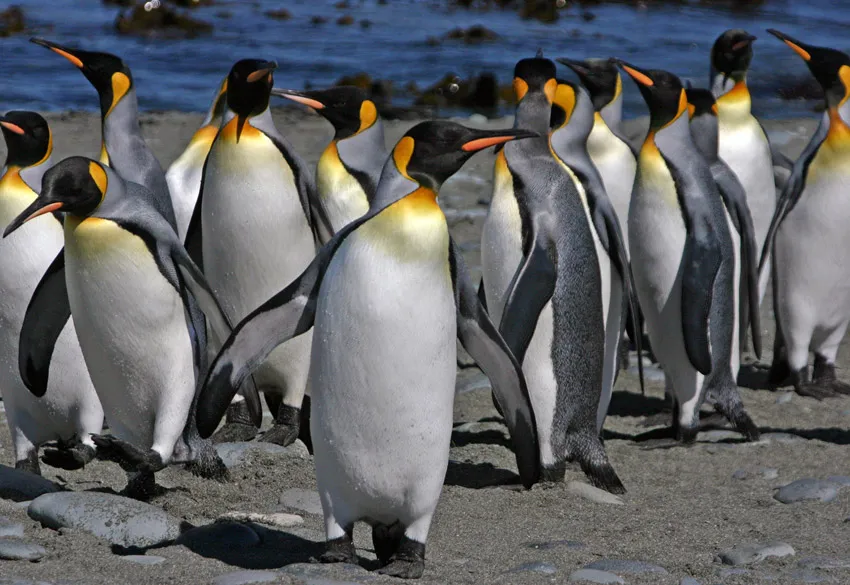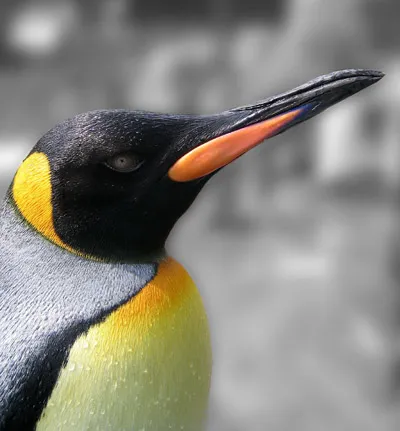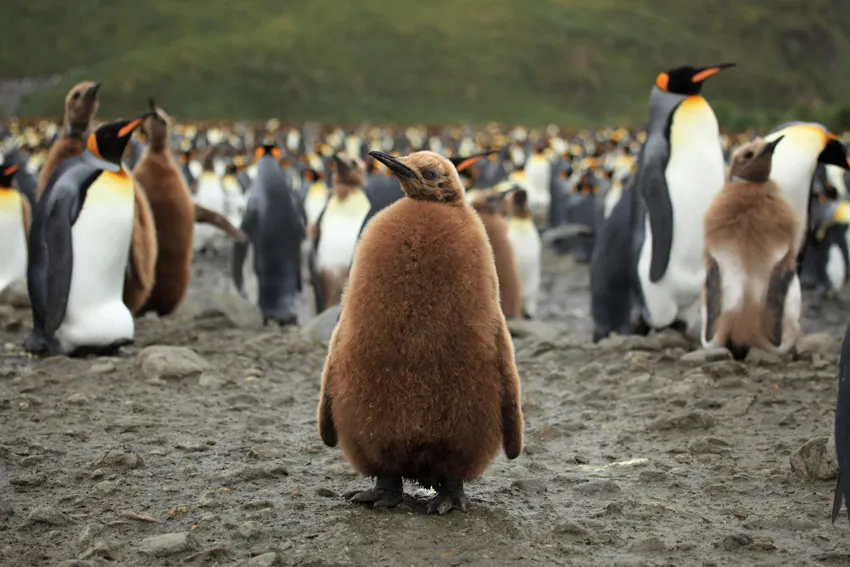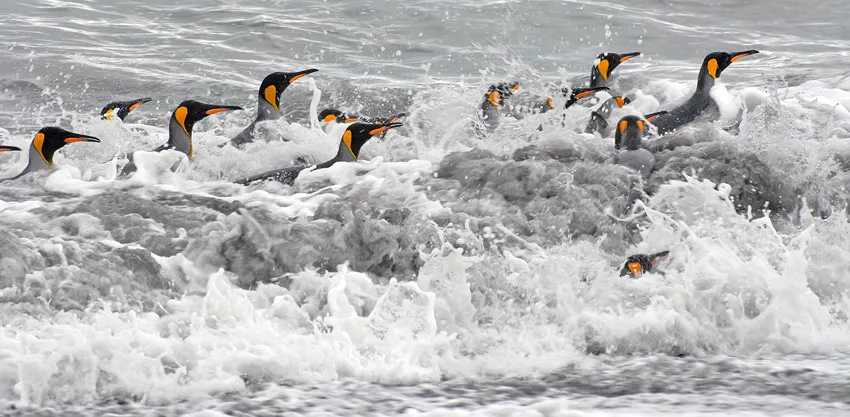King Penguins Facts - Aptenodytes patagonica
One of the species that people think of when the think of penguins. Along with Adelie penguins, and Emperor penguins they have come to represent the whole group.
King Penguin Basics
Average Weight: 15kg - 33lb
Average Height: 95cm - 3.1ft
Breeding Season: Starts in November
or January, a complex breeding system, individuals are either
early or late breeders and raise 2 chicks every 3 years.
Estimated world population: - 2 million
breeding pairs (some estimates up to 3.2 million), increasing.
Diet and Feeding: Mainly fish, also
squid, caught by pursuit diving down to 100m. Unusually
for Antarctic animals they eat little krill.
Conservation status: Least concern.
Distribution: Sub-Antarctic islands
46° to 55° South, some birds winter on the south coast
of Argentina, the largest colony is on South Georgia.
Predators: Leopard seals - main predators
of adult birds. Skuas - prey on eggs and chicks.
What are King penguins like?
King penguins are the second largest of the penguin species (after the Emperor penguin), on average they are around 15kg (33lb) and 95cm (3.1ft) high.
Like many penguins, fully grown but unfledged chicks can appear to be larger than the adult birds. They were sometimes known as "woolly penguins" by the early explorers and sealers as the thick brown down of the juveniles looks like wool on sheep. Some even thought they were a separate species, an impression strengthened by their complex breeding season meaning there are almost always some chicks around at all times of the year.
King penguins have colourful feathers around their necks and heads, this makes them the brightest of all the species of penguin, there is an estimated world population of 2 million breeding pairs with some estimates up to 3.2 million.
King penguins live on sub-Antarctic islands dotted around the continent from about 46° to 55° South where they form huge colonies on slopes with a nearby beach for access to the sea. King penguin colonies are occupied all the year round either by the chicks or the adults. Non-breeding birds may be found far from their home colony, particularly in the region of the Antarctic convergence and other places of upwelling (such as oceanic sea-mounts and islands) where there are good concentrations of fish and squid to be found that they feed upon.
Major colonies are found on Crozet, Prince Edward Island, Kerguelen Island, Heard Island, South Georgia and Macquarie Island. Two subspecies are recognized:
Aptenodytes patagonica patagonicus - The Falkland Islands and South Georgia.
Aptenodytes patagonica halli - Indian Ocean and South Pacific.

St. Andrews Bay South Georgia - the
largest King Penguin rookery in the world
picture courtesy
of Ella Derbyshire.

King penguins in Gold Harbour
South Georgia
picture courtesy of Ella Derbyshire.
What is unusual about the breeding cycle of King penguins?
King penguins don't make a nest, not even the perfunctory small pile of stones that other penguin species go for.
Instead, they lay only one egg at a time and carry it around on their feet covered with a flap of abdominal skin called the brood patch. It is looked after in this manner for the whole of the average 55 day incubation period, being shuffled from one parent to the other every 6-18 days. When relieved of the egg, that parent then goes off to sea on an extended food foraging trip.
Upon hatching, the chicks continue to be protected on the parents feet and the brood patch for another 30-40 days after which time, they are large enough to be able to regulate their temperature for themselves. It can be many days, 3-14 between parents swapping duties, so the chick has to wait some considerable time between feeds.
King penguins live on Antarctic and sub-Antarctic islands rather than in the deep south. There are two distinct groups, "early breeders" and "late breeders". Early breeders lay eggs in November (early summer) which hatch around mid-January, the chicks are reared and reach about 90% of adult weight by April when they are independent. An individual penguin can flip between being an early or late breeder.
Late breeders lay and incubate their eggs from January until March, late summer. Parental visits become fewer and further between over the winter and the chicks are left to survive blizzards and severe conditions on their own. They huddle together in creches and keep alive by using their fat reserves, the parents return to feed them about once every four to six weeks.
It can be as much as 3 months between feeds however and a 5 month wait has even been endured by a surviving chick. The chicks may lose up to 50% of their body weight at these times.
Though harsh, the winter conditions are nowhere near as bad as emperor penguins are enduring further south.

A creche of king penguin
chicks
As food supplies improve the following spring, so the parents return more frequently and then by December, the last of the chicks have left to fend for themselves.
The parents will then moult, leave to go to sea for several weeks to fatten up again and then become the late breeders for that season.
Any parents that have lost their eggs or chicks during the winter will become that seasons early breeders.
In this unusual breeding cycle, king penguins usually only average one chick every two years or at most two in a three year cycle. The king penguin is restricted in range to ice free areas as a consequence of having to feed its chick through the winter.
How do King penguins live their lives?
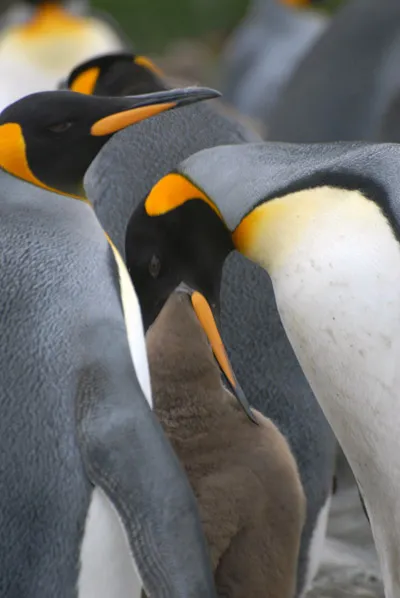 King penguins leave the colony where they
were born when they have fledged fully and so are able to swim
in the sea and catch their own food. They cannot go
into the water until they have lost their fluffy brown juvenile
down that is an excellent insulator in the air, but a very poor
insulator when wet. They will not return again to breed until
they are at least 3 years old, when they will usually return
to the site where they were born and continue to do so through-out
their life which can last up to 30 years in captivity.
King penguins leave the colony where they
were born when they have fledged fully and so are able to swim
in the sea and catch their own food. They cannot go
into the water until they have lost their fluffy brown juvenile
down that is an excellent insulator in the air, but a very poor
insulator when wet. They will not return again to breed until
they are at least 3 years old, when they will usually return
to the site where they were born and continue to do so through-out
their life which can last up to 30 years in captivity.
Breeding is preceded by a moult where they lose their old feathers and have them replaced by new ones. Like the juveniles, adults cannot fish for food until they have a new fully intact and functioning set of feathers, so this moult period is one of starvation while living on food reserves.
Return to the breeding colony by the adults does not happen en masse as it does with some other penguin species. This means that finding the same mate again is much less likely and so king penguins frequently change partners for each breeding cycle rather than pairing up with the same partner.
King penguins fitted with depth recorders have been found to dive to at least 50m (160ft) in about half of their dives. They regularly dive deeper than this and have been recorded at up to 500m (1600ft). Deep dives tend only to occur during the day time with only shallow dives being recorded at night which account for only a minority of fishing dives.
They hunt prey that produce light by bioluminescence which is presumably the way by which the penguins can see to fish at night.
So useful are king penguins at carrying depth recorders, that some have been used to carry depth and temperature sensors with them on dives to give scientists a 3-dimensional record of sea temperature at various depths in the Southern Ocean.
King penguins are subjected to tourist presence mainly in the Falkland Islands and also on South Georgia, the impact of tourism is very low currently. Penguins in general are tolerant of tourists and are not alarmed by their presence as long as they do not enter the colony.
King penguins are currently not influenced by any fishery as they themselves are not taken and their prey is not currently taken commercially, so industrial fishing is not affecting their numbers.
Picture credits: Top banner, Liam Quinn from Canada - stand alone chick, Creative common Share and Share Alike 2.0 license / Mike Usher - top picture / Mark Dickson - Penguin portrait, Creative common Share and Share Alike 2.0 license / Liam Quinn from Canada - stand alone chick, Creative common Share and Share Alike 2.0 license / Serge Ouachee - group of brown chicks, GNU 1. 2 license / Ulf Gustafsson - adult feeding chick and swimming penguins

